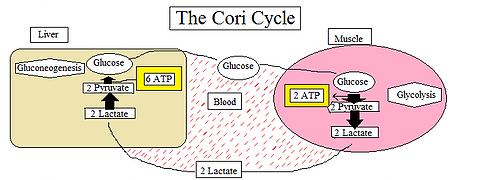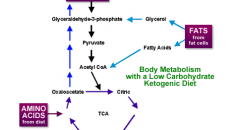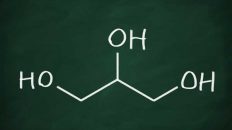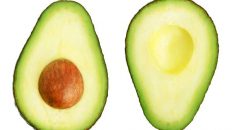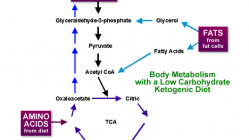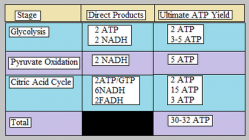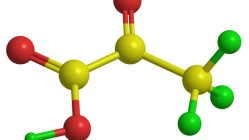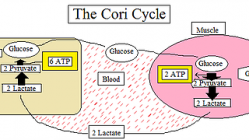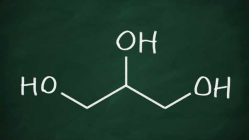Cori Cycle:
We have examined what happens after glycolysis when oxygen is available, but what happens when oxygen isn’t available? When oxygen isn’t readily available this triggers an anaerobic process that is known as the Cori Cycle- also known as the Lactic Acid Cycle.
Cori Cycle Explained:
Although our bodies prefer to produce energy with oxygen there are some cases where oxygen isn’t available, such as sprinting away from a saber tooth tiger or lifting weights. In these scenarios, our bodies create energy anaerobically for us to carry out these tasks. The energy comes from glucose via glycolysis where glucose is broken down into pyruvate. In oxidative cycles, human bodies will convert pyruvate into more energy, however, because we lack sufficient oxygen in these cases, pyruvate is converted into a substance called lactate. Once we have lactate our bodies may continue with glucose breakdown allowing for further energy production; our bodies can continue this style of energy production from 1 to 3 minutes. During this period lactate will accumulate to prominent level. What happens once our bodies cannot continue this style of energy production? This period is known as OBLA (Onset of Blood Lactate Accumulation) which is where lactic acid builds up in the blood stream and fatigue sets in; think of this as the point where we “hit a wall”. In short, OBLA is where lactate begins to accumulate in the blood faster than it can be removed.
Side Lesson:
**OBLA Examined:
To truly understand OBLA we must examine how lactate is formed during metabolism. Because we have only discussed utilizing carbs (glucose) as the energy source used in these energy cycles, let’s discuss how our bodies convert carbs into energy (get ready for review!). We know that our cells produce ATP which is broken down the provide the energy needed during activities. ATP is created in a three-step process (Glycolysis, Krebs Cycle, and the Electron Transport Chain (ETC)). We also know that a small amount of energy is created from Glycolysis and the Krebs Cycle, the real money maker comes from the ETC. During low intensity exercises we can sustain this process for prolonged periods of time, but once we demand a high intensity activity our bodies need more ATP than the ETC can produce. This demand stimulates a greater production from Glycolysis. During this phase, we start to see lactate being spilled out into the blood. Once our brains sense our blood contains excessive amounts of lactate we “hit a wall” and our bodies slow. This drop in intensity reduces the ATP demand thus slowing Glycolysis which allows lactate to be cleared from the blood.
***There are tests that can be done to show where your lactate threshold is. Usually the inflection point occurs at 4.0 mmol/L or 80-85% of their V02 Max.
***How is lactate cleared from the blood? The Cori Cycle creates an “oxygen debt”, this debt requires more oxygen from muscle tissues to oxidize lactate and replenish the depleted ATP from intense exercise.
Cori Cycle Continued:
Now that we have read the passage above, the following should be understandable.
The Cori Cycle is a metabolic pathway that is used to prevent lactic acid (produced by anaerobic glycolysis which we just discussed in the side lesson above) from building up in our muscles; this process occurs in the liver (Glycolysis).
*Buildup of excessive lactate in muscles is known as lactic acidosis
During fasting or exercise induced states, lactate from red blood cells (RBCs) or skeletal muscles is sent to the liver to make glucose which is returned to either RBCs or skeletal muscles. In this process, one molecule of glucose only produces two (2) ATP meaning this cycle is pretty inefficient in creating energy compared to the ATP produced in the Citric Acid Cycle (which is estimated to be about thirty (30) ATP). This is the reason why we fatigue faster from high intensity exercises than moderately intense exercises.
In the Cori Cycle, pyruvate is converted into lactate from the enzyme lactate dehydrogenase in a process known as lactic acid fermentation. This process is vital in regenerating and maintaining NAD+ levels which is needed for glycolysis to occur. The lactate produced in muscles is taken up by the liver where gluconeogenesis occurs. Lactate is then converted back into pyruvate and finally back into glucose via the oxygen debt.
*This glucose returns to the muscles via the bloodstream for further glycolysis reactions; if glucose is not required it is used to synthesize glycogen.
Terms Defined:
Lactate: a colorless syrupy organic acid formed in sour milk and produced in the muscle tissues during strenuous exercise
Gluconeogenesis: a metabolic pathway that results in the generation of glucose from certain non-carbohydrate carbon substrates
Pyruvate: a salt or ester of pyruvic acid
Glycogen: a substance deposited in bodily tissues as a store of carbohydrates. It is a polysaccharide that forms glucose on hydrolysis
Oxygen Debt: he amount of extra oxygen required by muscle tissue to oxidize lactic acid and replenish depleted ATP and phosphocreatine following vigorous exercise.

